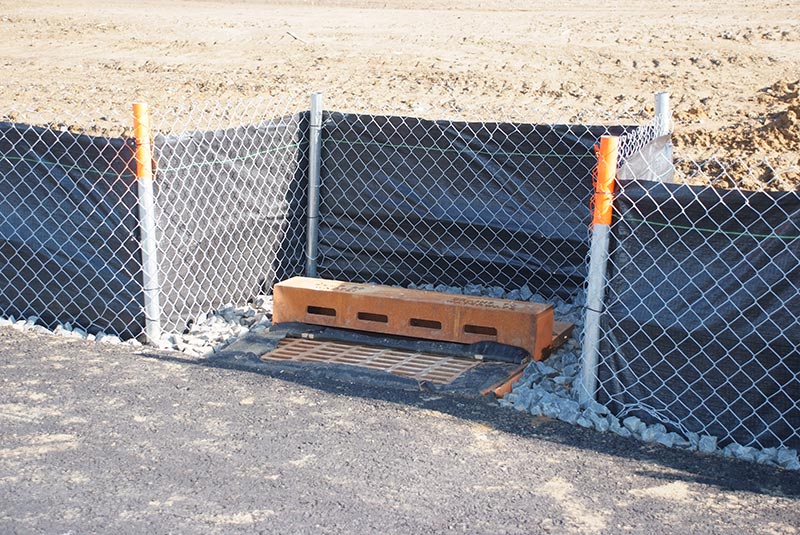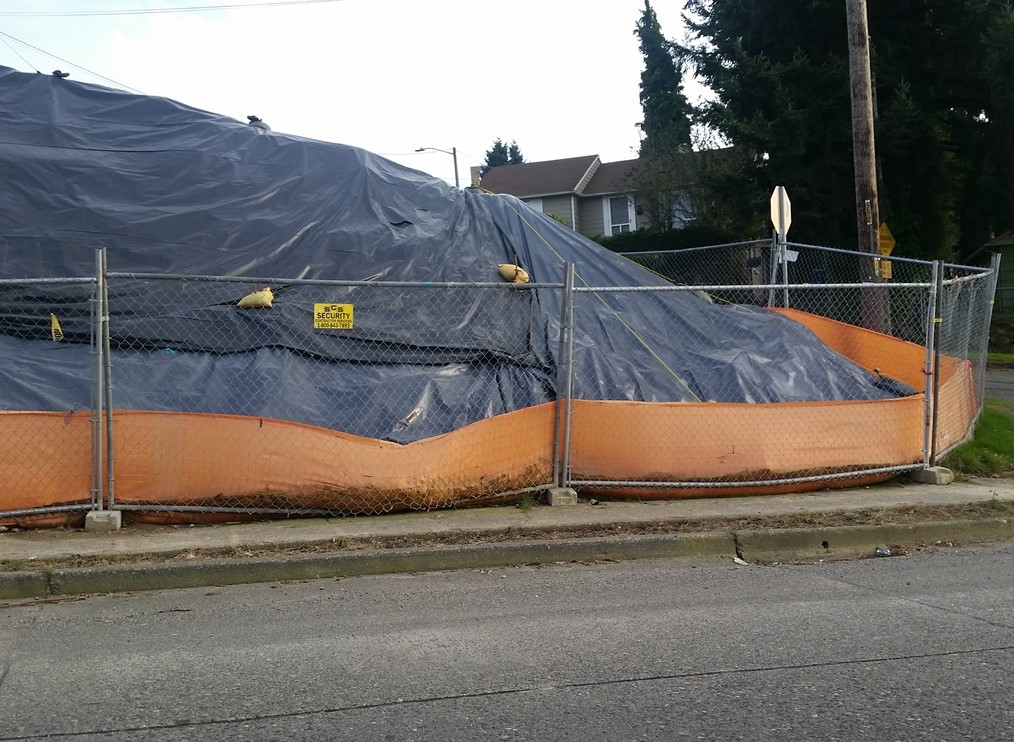Include Inlet Protection In Your Construction Practices
Don’t just build; build responsibly.
Incorporate inlet protection into your job site practices and enjoy the many benefits of a cleaner, safer, and more compliant construction project.
Invest in the future – start with inlet protection today!
Get An Inlet Protection Quote

One of the greatest environmental concerns we face these days is soil erosion. This is a widespread problem due to the rise of urbanization and a multitude of construction projects that are ongoing. Inlet protection helps mitigate the negative effects of soil erosion that results from soil disturbance on New Jersey construction sites.
When buildings are constructed, the land is ripped up and dug out, exposing the soil to possible erosion. Sediments dug up during construction can find their way to the city’s water system through storm sewers, storm grates and storm inlets. This includes large projects and small projects.
Because of the potential danger to our environment, the government has required contractors to use a professional-grade inlet filter and to erect their own sediment control solutions and measures when starting any new project. Inlet protection can be constructed from rock socks, sediment control logs, silt fence, block and rock socks, or other materials approved by the local jurisdiction.
Understanding the Basics of Inlet Protection
Inlet protection is a crucial aspect of inlets construction practices that involves preventing sediment, debris, and other contaminants from entering stormwater drainage systems. This temporary sediment control measure is essential for diverting water laden with pollutants away from the drainage system, thereby preventing the clogging of storm sewer inlets and local streams. By maintaining water quality, inlet protection plays a vital role in safeguarding the environment.
Inlet protection devices are specifically designed to capture sediment and other contaminants before they enter the drainage system. These devices can be installed in various locations, including catch basins, curb inlets, and storm sewer inlets. Typically used in areas with unstabilized land, such as construction sites, utility work areas, and landscape renovations, inlet protection ensures that debris and pollutants are effectively managed.
The Benefits of Securing Your Job Site with Inlet Protection
Erosion Control in Your Drainage System
Inlet protection acts as a robust barrier against sediment runoff, preventing erosion and maintaining the integrity of your job site. It ensures that valuable soil stays in place, reducing the environmental impact. Regular maintenance is crucial to remove sediment build-up from inlet protection devices to maintain their safety and efficacy.
Compliance with Regulations
Stay on the right side of environmental regulations. Inlet protection measures demonstrate your commitment to responsible construction practices, helping you avoid potential fines and delays associated with non-compliance.
Water Quality Preservation
By effectively filtering and trapping sediment, inlet protection contributes to preserving water quality. This not only benefits the surrounding environment but also safeguards local water bodies from contamination. Drainage inlets and catch basins are commonly used in parking lots to manage excess stormwater runoff, ensuring efficient drainage solutions in both sag and on-grade configurations.
Long-Term Cost Savings
Investing in inlet protection upfront can save you money in the long run. By preventing sedimentation in stormwater systems, you reduce maintenance costs and potential damages to downstream infrastructure.
Maintaining Project Schedule
Sediment runoff can lead to delays and disruptions on the job site. Inlet protection helps keep your project on schedule by minimizing the impact of erosion and ensuring a stable work environment.

Enhanced Safety
A well-protected inlet adds an extra layer of safety to your job site. It minimizes the risk of sediment-related accidents, creating a secure working environment for your team. Maintaining and analyzing a particular inlet is crucial to ensure its proper functionality and safety, especially during winter conditions.
Community Relations
Show your commitment to environmental stewardship and community well-being. Implementing inlet protection measures demonstrates responsible construction practices, enhancing your reputation with local communities.
Identifying Different Inlet Types for Effective Protection
There are several types of storm drain inlets that can be used for effective inlet protection, each serving a specific purpose:
- Curb Inlets: The most common type of storm drain inlet, curb inlets are typically used in urban areas to capture stormwater runoff from streets and sidewalks.
- Curb Grate Inlets: Similar to curb inlets, these inlets feature a grate or screen to capture debris and sediment, preventing them from entering the drainage system.
- Drop Curb Inlets: Designed for areas with heavy stormwater runoff, drop curb inlets are capable of capturing large amounts of water, making them ideal for high-flow situations.
- Combination Inlets: Used in areas with high stormwater runoff, combination inlets are designed to capture both stormwater and debris, ensuring comprehensive protection.
Choosing the right type of inlet is essential for effective inlet protection, as it ensures that the specific needs of the drainage area are met.
Innovative Methods to Safeguard Your Construction Site
Several techniques can be employed for effective inlet protection, each designed to capture sediment and other contaminants before they enter the drainage system:
- Inlet Protection Devices: These devices are specifically designed to capture sediment and other contaminants, preventing them from entering the drainage system. Examples include silt sacks, filter fabric wraps, and coir wattles.
- Sediment Traps: These traps are designed to capture sediment and other contaminants in stormwater runoff, preventing them from reaching storm sewer inlets.
- Erosion Control Measures: Implementing erosion control measures, such as silt fences and straw wattles, helps prevent soil disturbance and erosion on construction sites, reducing the amount of sediment that can enter the drainage system.
- Regular Maintenance: Ensuring that inlet protection devices are functioning properly requires regular maintenance. This includes inspecting and cleaning devices to remove accumulated sediment and debris.
By understanding and implementing these techniques, construction sites can be effectively safeguarded, and water quality can be maintained. Inlet protection is an essential aspect of responsible construction practices, helping to prevent sediment, debris, and other contaminants from entering stormwater drainage systems.

Coir Wattles
These wattles are 6” x 12’ machine fabricated cylinders consisting of 100% coconut fiber encased in a high tensile machine spun bristle coconut coir fiber twine. Coirwattles come with a protective burlap wrapping.
Small in diameter and versatile, coirwattles can be used on slopes, wrapped around culverts, replace straw bales and silt fencing, just to name a few! They slow the flow of water to reduce erosion and slow the run off by interrupting the length of the slope.
Wooden Inlet
Our filter fabric inlet protection consists of a 4×4 wood box frame with holes and rock around the box.
This is used for reducing the amount of silt and debris that may enter a storm water inlet during construction. The stone and wood frame is placed around the storm drain to collect debris as it enters the opening.


Siltsack for Storm Drain Inlets
Siltsack inlet protection is a sediment control device used to prevent silt and sediment from entering your drainage system. It catches the silt and sediment while allowing water to pass through freely.
Siltsack can be used as a primary or secondary sediment control device to prevent failure of your drainage system due to clogging. It must be maintained on a regular basis to function properly. Regular maintenance is essential to remove sediment build-up and ensure the Siltsack remains effective.
Call 732-370-0291 or Contact Us for Inlet Protection Solutions for Your New Jersey Construction Site
Also Available
- Chicken wire with stone
- Coir logs
- Filter fabric wrap
- Straw wattles
Additional Resources About NJ Erosion Control
Maintaining Erosion Control Measures During Construction Projects
Construction professionals must prioritize the importance of maintaining erosion control measures or be faced with…
Stockpile Management for Erosion and Sediment Control
Soil stockpiles are an essential part of construction projects, as they provide the necessary material…
Maximizing Erosion Control With Stabilized Construction Access
Construction sites are dynamic environments where heavy machinery, excavation, and movement of materials are part…
Sediment Buildup Prevention: Low-Flow Channel Solutions
Erosion and sediment accumulation present multifaceted challenges across New Jersey’s landscapes. Sediment buildup leads to…
Year-Round Erosion Control in New Jersey
Erosion is the gradual process of wind, water, or other natural agents wearing away soil….
E&S Plans for Sustainable Land Development
Commercial Sitework on RT9 S in Howell, NJ featuring both erosion control silt fence and Safety…






